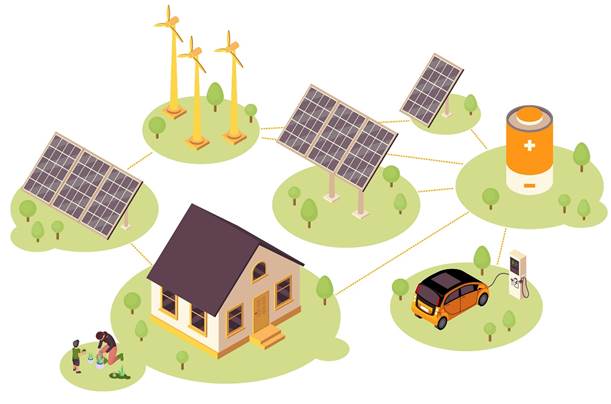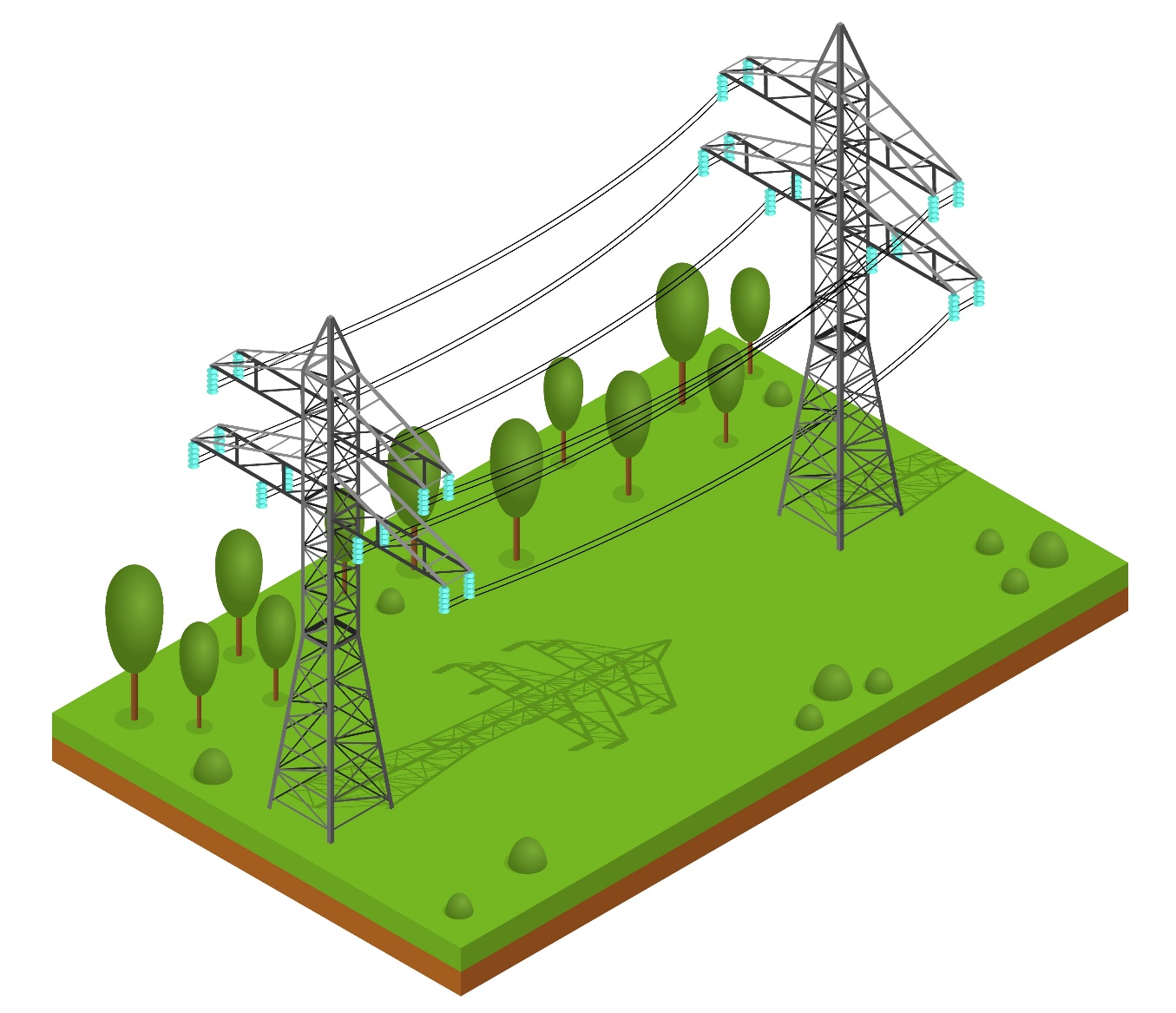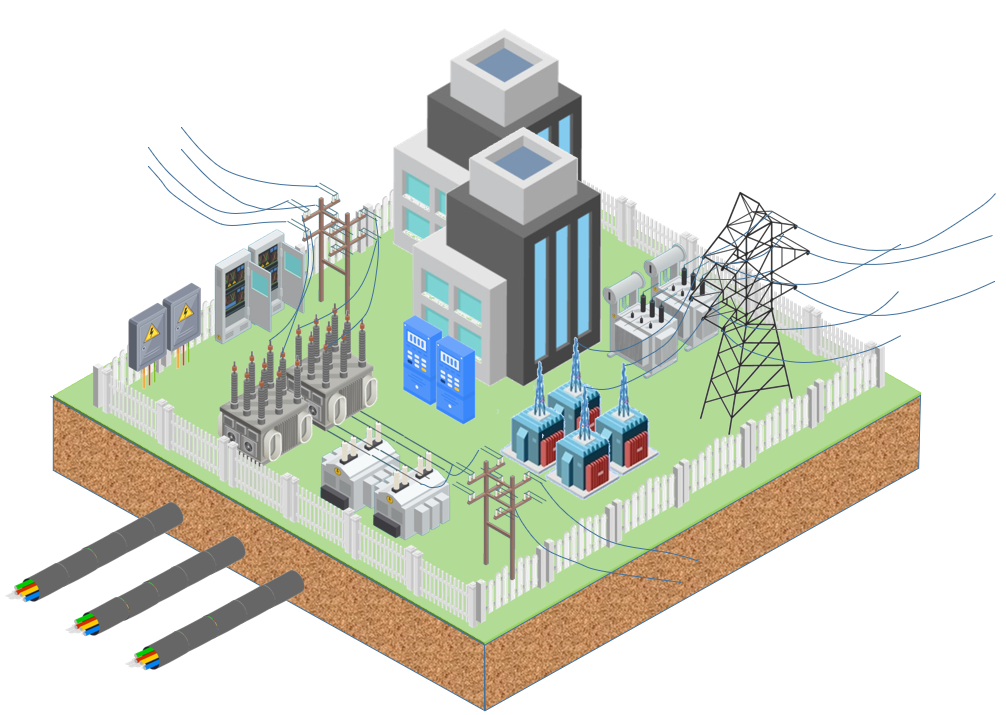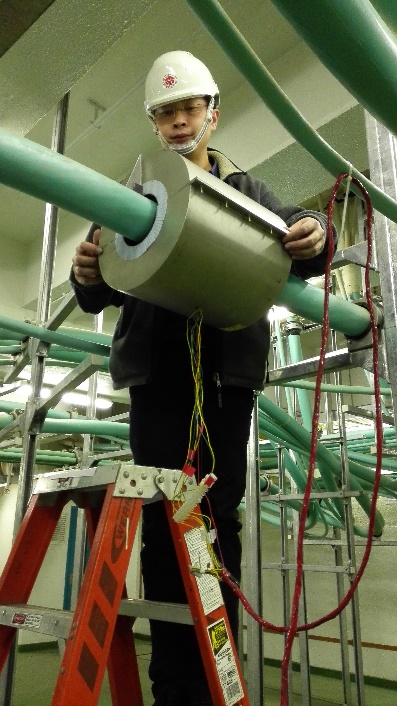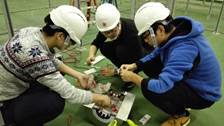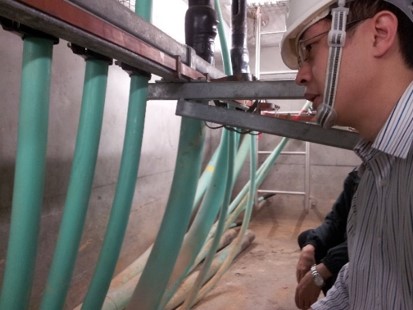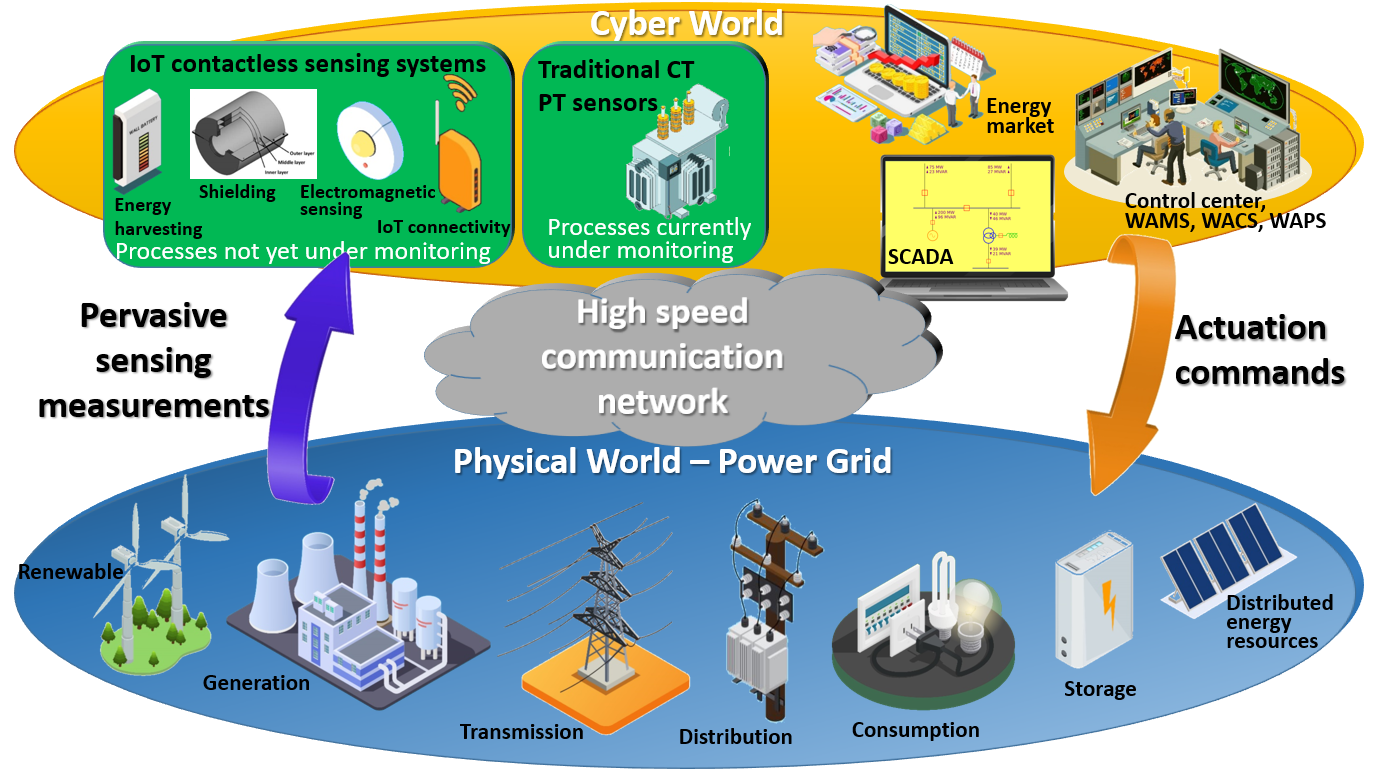|
Green Technology Research and Training Laboratory |
||||||||||||||||
|
Sensor Research Laboratory |
||||||||||||||||
|
|
|
|
|
|
|
|
|
|
|
|
|
|||||
|
|
|
|
|
|
|
|
|
|
|
|
|
|||||
|
|
WE are living in an age of sensors and the trillion-sensor society is coming. The sensor technology will have great impacts in making our lives and infrastructures smarter, more efficient, and more sustainable. Smart city, smart living and smart grid are envisioned to be a promising solution to the rapid urbanization which results in ecological, economic, social and infrastructural concerns. Our Laboratory focuses on electromagnetic sensor measurement and data analysis to extract critical information for decision making in these new paradigms. You can find introduction to our research directions as well as our major external grant record in this webpage. |
|
||||||||||||||
|
|
|
|
|
|
|
|
|
|
|
|
|
|||||
|
|
|
|
|
|
|
|
|
|
|
|
|
|||||
|
|
Electromagnetic sensing in smart city and smart living: |
|
||||||||||||||
|
|
|
|
|
|
|
|
|
|
|
|
|
|||||
|
|
|
|
||||||||||||||
|
|
|
|
|
|
|
|
|
|
|
|
|
|||||
|
|
ELECTROMAGNETIC sensors such as magnetoresistive (MR) magnetic sensors with excellent sensitivity to electromagnetic field, low power consumption, compactness and CMOS compatibility can be one of the critical sensing devices supporting the Internet of Things (IoT) and enabling smart city. Smart city provides a trending and connected lifestyle that envisions efficient and sustainable energy utilization, stable and reliable power supply, and intelligent and coordinated transportation and mobility. Realization of pervasive sensing needs the IoT which is a compelling platform providing connectivity for trillions of sensors and collecting data for analytics. Pervasive sensing is more advanced than traditional monitoring systems where limited sensors and wired communication can merely collect fragmented data in the application domains. The Sensor Research Laboratory @NJIT endeavors to realize contactless sensing with electromagnetic sensors in electrical current sensing, transmission and distribution lines monitoring, vehicle detection, and other detection and monitoring applications in smart city and smart grid. |
|
||||||||||||||
|
|
|
|
|
|
|
|
|
|
|
|
|
|||||
|
|
|
|
|
|
|
|
|
|
|
|
|
|||||
|
|
To learn more about magnetoresistive sensors
(also known as spintronic sensors) and how they can contribute to smart
living, please read our paper "Overview
of spintronic sensors with internet of things for smart living". |
|
||||||||||||||
|
|
|
|
|
|
|
|
|
|
|
|
|
|||||
|
|
|
|
|
|
|
|
|
|
|
|
|
|||||
|
|
|
|
|
|
|
|
|
|
|
|
|
|||||
|
|
|
|
|
|
|
|
|
|
|
|
|
|||||
|
|
|
|
|
|
|
|
|
|
|
|
|
|||||
|
|
|
|
|
|
|
|
|
|
|
|
|
|||||
|
|
Electromagnetic
sensing in smart grid: |
|
||||||||||||||
|
|
|
|
|
|
|
|
|
|
|
|
|
|||||
|
|
|
|
||||||||||||||
|
|
|
|
|
|
|
|
|
|
|
|
|
|||||
|
|
TODAY, electric power grid is the single greatest engineering establishment on earth of the 20th century. Tomorrow, the smart grid will be one of the greatest achievements of the 21st century. By incorporating the state-of-the-art technologies with the electric power grid to make the grid intelligent, the smart grid promises many benefits including increased energy efficiency, reduced carbon emissions, improved power reliability and integration of renewable energy. Advanced sensors have a lot to contribute to the smart grid. Areas including energy monitoring, load balancing, security monitoring, equipment inspection, and many others require sensing technologies, and sensors will be deployed in power plants, substations, transmission and distribution networks to enable remote monitoring, situational awareness, self-healing, dynamic line rating, efficiency enhancement, peak demand reduction, etc., in the smart grid. It is well-known from the electromagnetic theory that electric current generates magnetic field, and the information of the current together with the condition of the power system is already embedded in the magnetic field. By measuring the magnetic field, we can actually obtain a lot of information about the status of the power grid. The superior sensitivity of magnetoresistive sensors including TMR (tunneling magnetoresistance) and GMR (giant magnetoresistance) sensors is of great use in this regard. The smart grid can be the next major application area of magnetoresistive sensors besides hard disk drives. |
|
||||||||||||||
|
|
|
|
|
|
|
|
|
|
|
|
|
|||||
|
|
|
|
|
|
|
|
|
|
|
|
|
|||||
|
|
To learn more about the details including working principle and
applications and outlook of magnetoresistive
sensors, please read our paper "Magnetoresistive
sensor development roadmap (non-recording applications)". To learn more about the relation between smart grid and
magnetics, please read our paper "Magnetics in smart grid". |
|
||||||||||||||
|
|
|
|
|
|
|
|
|
|
|
|
|
|||||
|
|
|
|
|
|
|
|
|
|
|
|
|
|||||
|
|
To materialize the future of smart city, smart living and smart grid, our Laboratory actively conduct research in these specific topics described below to bring technological breakthroughs in various aspects of our lives. |
|
||||||||||||||
|
|
|
|
|
|
|
|
|
|
|
|
|
|||||
|
|
|
|
|
|
|
|
|
|
|
|
|
|||||
|
|
|
|
|
|
|
|
|
|
|
|
|
|||||
|
|
|
|
|
|
|
|
|
|
|
|
|
|||||
|
|
|
|
|
|
|
|
|
|
|
|
|
|||||
|
|
Contactless sensing
technology based on electromagnetic field sensing for transmission- and
distribution- grids monitoring: |
|
||||||||||||||
|
|
|
|
|
|
|
|
|
|
|
|
|
|||||
|
|
|
|
||||||||||||||
|
|
|
|
||||||||||||||
|
|
HIGH-VOLTAGE transmission lines are the most effective way for long-distance power delivery from sources to distribution networks with the maximum ampacity. These days, the planning, operation, and maintenance of the power grid can be improved by employing large-scale wide-area monitoring, protection and control (WAMPAC) applications [1]. Wide-area monitoring requires the operation states of the transmission-line networks to be monitored and reported to the control center in real time. Both the electrical and spatial parameters of the transmission lines should be accurately detected. It drives the development of a real-time operation-state monitoring technology which is able to measure electrical parameters, including amplitude, phase angle, frequency, and waveform of the phase currents. On the other hand, the technology should also be able to obtain spatial parameters, including conductor sagging and galloping of the transmission lines. Our Laboratory developed a novel noncontact technology of operation-state monitoring based on magnetic-field sensing for high-voltage transmission lines, which can simultaneously measure both electrical and spatial parameters in real time. This technology was derived from research on themagnetic-field distribution at the ground levelwhen the transmission lines operate in different states, including sagging, galloping, and current imbalance. The technology can be potentially applied in the transmission lines in large scale for finding out the abnormal parameter changes of transmission-line spans in order to enable engineers to accurately and quickly locate the fault. |
|
||||||||||||||
|
|
|
|
|
|
|
|
|
|
|
|
|
|||||
|
|
|
|
|
|
|
|
|
|
|
|
|
|||||
|
|
To learn more, please read our paper "Noncontact
operation-state monitoring technology based on magnetic-field sensing for
overhead high-voltage transmission lines". |
|
||||||||||||||
|
|
|
|
|
|
|
|
|
|
|
|
|
|||||
|
|
|
|
|
|
|
|
|
|
|
|
|
|||||
|
|
|
|
|
|||||||||||||
|
|
|
|
|
|
|
|
|
|
|
|
|
|||||
|
|
UNDERGROUND power cables are commonly used for delivering electricity from distribution networks to customers in metropolises. Operation-state monitoring for underground power cable is required so that engineers can be aware of the cable operation state in time and manage the maintenance to avoid serious power incidents. Besides, very often, onsite works have to be carried out on the underground cable system due to either regular maintenance or unexpected incidents. Correct identification of the target cable from a bundle of power cable for works is an essential task in view of reliability of electricity supply system. Energization status identification is challenging due to congested underground utility services in almost every part of a major city. Especially for energized cables without load current (i.e. voltage-energized), their energization status are difficult to detect because the detective principle of all the existing cable detection instruments is based on the magnetic field emanated from the load current. It poses a thorny challenge to engineers to identify correctly the target cable before spiking the cable for works. In this work, a novel method based on magnetic field sensing is developed for monitoring the operation-state and identifying the energization-status of underground power cables. Currently, commercially available magnetoresistive (MR) magnetic sensors are widely used which thanks to its sensitivity down to around 10−9 Tesla and high spatial resolution of 0.9 mm. Based on the measured magnetic field, the engineers can find out the cable operation state and obtain its electrical information in real time. When work is carried out on the target cable, this technology can be used to find out the energization status of the target cable before spiking the cable and thus it guarantees the safety of engineer and electricity supply to customers will not be interrupted. |
|
||||||||||||||
|
|
|
|
|
|
|
|
|
|
|
|
|
|||||
|
|
|
|
|
|
|
|
|
|
|
|
|
|||||
|
|
To learn more, please read our paper "Operation-state
monitoring and energization-status identification for underground power
cables by magnetic field sensing". |
|
||||||||||||||
|
|
|
|
|
|
|
|
|
|
|
|
|
|||||
|
|
|
|
|
|
|
|
|
|
|
|
|
|||||
|
|
|
|
|
|
|
|
|
|
|
|
|
|||||
|
|
|
|
|
|
|
|
|
|
|
|
|
|||||
|
|
|
|
|
|
|
|
|
|
|
|
|
|||||
|
|
|
|
|
|
|
|
|
|
|
|
|
|||||
|
|
Substation current measurement based on magnetic sensor array: |
|
||||||||||||||
|
|
|
|
|
|
|
|
|
|
|
|
|
|||||
|
|
|
|
||||||||||||||
|
|
|
|
|
|
|
|
|
|
|
|
|
|||||
|
|
CURRENT monitoring at substations can facilitate preemptive action in electrical distribution network, so as to relieve power congestion, improve transmission efficiency, and ensure network reliability. The non-invasive current sensing devices are promising since they do not require contacting hazardous high voltage and their installation is much easier compared with invasive current sensing devices. However, the existing non-invasive current sensing devices, such as current clamps and Rogowski coils are only applicable for measuring single-core underground power cables. We successfully developed and demonstrated a non-invasive technique, that can monitor the currents of a multi-core underground power cable by measuring the emitted magnetic field around the cable surface. Magnetoresistive (MR) magnetic sensors in a circular array were adopted to measure magnetic field around the cable surface, and a triple-layer shielding was designed to reduce the effects of external interference. Regarding intrinsic noise in MR sensors (e.g., 1/f noise and thermal noise), magnetic flux concentrators were supplemented to improve the signal-to-noise ratio. This technology was implemented and validated in a substation, and the reconstructed results closely matched the real geometrical configuration and current records of the tested cable. Apart from the non-invasive feature, the platform also shows great potential to improve the sensing capability of current amplitude and frequency compared with CTs by adopting MR sensors. |
|
||||||||||||||
|
|
|
|
|
|
|
|
|
|
|
|
|
|||||
|
|
|
|
|
|
|
|
|
|
|
|
|
|||||
|
|
To learn more, please read our paper "On-site
non-invasive current monitoring of multi-core underground power cables with a
magnetic-field sensing platform at a substation". |
|
||||||||||||||
|
|
|
|
|
|
|
|
|
|
|
|
|
|||||
|
|
|
|
|
|
|
|
|
|
|
|
|
|||||
|
|
|
|
|
|
|
|
|
|
|
|
|
|||||
|
|
|
|
|
|
|
|
|
|
|
|
|
|||||
|
|
|
|
|
|
|
|
|
|
|
|
|
|||||
|
|
|
|
|
|
|
|
|
|
|
|
|
|||||
|
|
Cyber-enabled grids
with contactless sensing based on electromagnetic field sensing: |
|
||||||||||||||
|
|
|
|
|
|
|
|
|
|
|
|
|
|||||
|
|
|
|
||||||||||||||
|
|
|
|
|
|
|
|
|
|
|
|
|
|||||
|
|
AS the penetration of distributed energy resources based on renewable sources increases, several technical challenges are introduced into energy grids. These include real-time power balance, control of bi-directional energy flow, power quality, distributed optimization, state estimation and topology estimation in distribution grids, and multi-level electricity trading. To overcome these challenges and to create situational awareness in energy grids, pervasive sensing becomes essential. To overcome hurdles such as implementation and cost of such pervasive sensing, in addition to traditional contact-sensing methods, contactless sensors that can measure key variables in the grid needs to be leveraged. Contactless sensing based on electromagnetic field sensing enables measurement of process variables that may be hard to measure due to technological limitations of contact sensing, large measurement delays, or high costs. In addition to contactless sensing, pervasive sensing proves advantageous as it can leverage ongoing technological advances in Internet of Things (IoT), as they can lead to enhanced network connectivity between sensors as well as between the edge and the cloud. Finally, pervasive sensing proves even more attractive by integrating contactless sensing not only with wireless communication but also with shielding and energy harvesting. Sensing techniques based on electromagnetic field sensing encompassing contactless sensing technologies, IoT connectivity, energy harvesting and shielding will have a lot to offer to a Cyber-Enabled Grid (CEG) and ultimately an Autonomous Energy Grids (AEGs), a futuristic concept where the grid will be making automated operational decisions. |
|
||||||||||||||
|
|
|
|
|
|
|
|
|
|
|
|
|
|||||
|
|
|
|
|
|
|
|
|
|
|
|
|
|||||
|
|
To learn more, please read our
paper "Cyber-enabled
grids: shaping future energy systems". |
|
||||||||||||||
|
|
|
|
|
|
|
|
|
|
|
|
|
|||||
|
|
|
|
|
|
|
|
|
|
|
|
|
|||||
|
|
|
|
|
|
|
|
|
|
|
|
|
|||||
|
|
|
|
|
|
|
|
|
|
|
|
|
|||||
|
|
|
|
|
|
|
|
|
|
|
|
|
|||||
|
|
|
|
|
|
|
|
|
|
|
|
|
|||||
|
|
Contactless
monitoring of renewable energy systems based on contactless sensing based on
magnetic field sensing: |
|
||||||||||||||
|
|
|
|
|
|
|
|
|
|
|
|
|
|||||
|
|
|
|
||||||||||||||
|
|
|
|
|
|
|
|
|
|
|
|
|
|||||
|
|
PHOTOVOLTAIC (PV) systems are one of the most popular renewable
energy systems, and the installation of PV systems has been growing rapidly.
According to the International Renewable Energy Agency (IRENA), the
cumulative global PV installations reached 480 GW at the end of 2018. In the
system level, there are ground faults, line-line faults, overcurrent faults
and arc faults in a PV system. The abnormal conditions of devices also hinder
the normal operation of a PV system. In PV systems, the aluminum electrolytic
capacitors (AECs) are widely used for filtering applications in power
electronic converters due to their high energy density and low cost. However,
the electrolyte vaporization, which leads to a decrease in capacitance (C)
and an increase in equivalent series resistance (ESR), restricts the lifetime
of an AEC. It is claimed that about 30 % of the failures in power electronic
converters are caused by AECs. The AEC is one of the most vulnerable
components in power electronic converters and challenges the reliability and
efficiency of PV systems. Therefore, the condition monitoring of AECs is
essential to ensure the reliability and efficiency of PV systems. The online-monitoring scheme for AECs in PV systems were developed in our Laboratory with MR magnetic sensors non-invasively. The voltage drops on C is considered in the method to improve the accuracy of ESR-estimation and the equation to estimate C is derived. The tunneling magnetoresistive (TMR) sensor, which is competent for measuring the magnetic field, can be utilized to sense the current of AECs up to 1 MHz non-invasively. The low-cost TMR sensor is compact in size (typically less than 15 mm3) and consume very little power (typically less than 0.4 mW), and it can be integrated on the printed circuit boards (PCBs) of power converters to measure the current effectively. This condition monitoring technique based on the estimation of ESR by using the current measured by magnetic-field sensing is applicable for the boost converters. This technique can achieve the realtime condition monitoring of AECs through the estimation of ESR in high accuracy with magnetic sensors such as TMR sensors. A promising online-monitoring system of AECs can be developed for a power electronic converter in PV systems and other power systems by the proposed technique. |
|
||||||||||||||
|
|
|
|
|
|
|
|
|
|
|
|
|
|||||
|
|
|
|
|
|
|
|
|
|
|
|
|
|||||
|
|
To learn more about the application of contactless sensing in
monitoring microgrid, please read our papers "Condition
monitoring of electrolytic capacitors in boost converters by magnetic sensors"
and "Online
monitoring of aluminum electrolytic capacitors in photovoltaic systems by magnetoresistive sensors". |
|
||||||||||||||
|
|
|
|
|
|
|
|
|
|
|
|
|
|||||
|
|
|
|
|
|
|
|
|
|
|
|
|
|||||
|
|
|
|
|
|
|
|
|
|
|
|
|
|||||
|
|
|
|
|
|
|
|
|
|
|
|
|
|||||
|
|
|
|
|
|
|
|
|
|
|
|
|
|||||
|
|
|
|
|
|
|
|
|
|
|
|
|
|||||
|
|
Contactless monitoring for electric-vehicle transportation based on magnetic field sensing: |
|
||||||||||||||
|
|
|
|
|
|
|
|
|
|
|
|
|
|||||
|
|
|
|
|
|||||||||||||
|
|
|
|
|
|
|
|
|
|
|
|
|
|||||
|
|
DUE to the advantages such as high efficiency, high power density,
and high power-to-volume ratio, permanent magnet synchronous machines (PMSMs)
have attracted considerable interest in many industrial applications of
electric vehicles and wind turbines. Unexpected faults or failures of PMSMs
could lead to costly repair or replacement, or even a catastrophic system
failure in several mission-critical applications. Therefore, the reliable and
valid health monitoring and early fault-diagnostic are highly desired to
ensure the high performance of PMSMs over long periods of time. Fast online
detection of inter-turn short-circuit faults for permanent magnet synchronous
machines (PMSMs) is a challenging task. Our Laboratory developed a new
technology to online inter-turn short-circuit fault detection for PMSMs by
means of sensing the external stray magnetic field outside the motor stator
yoke. The stray magnetic field provides the information about the phase
currents as well as the status of stator windings and thus, the location of
interturn short-circuit fault can be detected accordingly. THE inductive power transfer (IPT) technology using magnetic resonance for wireless electric vehicle (EV) charging has attracted considerable attention since it enables the dynamic wireless charging (DWC) of a roadway EV. However, the misalignment tolerance between the vehicle mounted receiving coil and ground-embedded transmitting coil is still a challenging problem for the commercialization of wireless EV charging. The charging power and efficiency will drop due to the lateral coil misalignment which easily occurs in the practical driving situations. a tunneling magnetoresistive (TMR) sensor-array-based misalignment-tolerant wireless charging system for roadway EVs is proposed in this paper, which makes use of the easy-to-fabricate coil design and low-cost TMR sensor array. TMR sensors have been widely used in magnetic field measurement applications such as in EVs due to their advantages such as low cost, compact size, high sensitivity, wide operating bandwidth, and low power consumption. Higher transferred power as well as wireless charging efficiency can be obtained using the cost-effective TMR-sensor-array and easy-to-fabricate receiving coils. This technique can provide sights to more flexible and easy-to operate misalignment-tolerant wireless charging solution for the roadway EVs. |
|
||||||||||||||
|
|
|
|
|
|
|
|
|
|
|
|
|
|||||
|
|
|
|
|
|
|
|
|
|
|
|
|
|||||
|
|
To learn more about application of magnetic sensors in electric
vehicles, please read our papers "Inter-Turn
Short-Circuit Fault Detection Approach for Permanent Magnet Synchronous
Machines Through Stray Magnetic Field Sensing" and "TMR-Sensor-Array-Based
Misalignment-Tolerant Wireless Charging Technique for Roadway Electric
Vehicles". |
|
||||||||||||||
|
|
|
|
|
|
|
|
|
|
|
|
|
|||||
|
|
|
|
|
|
|
|
|
|
|
|
|
|||||
|
|
|
|
|
|
|
|
|
|
|
|
|
|||||
|
|
|
|
|
|
|
|
|
|
|
|
|
|||||
|
|
|
|
|
|
|
|
|
|
|
|
|
|||||
|
|
|
|
|
|
|
|
|
|
|
|
|
|||||
|
|
Major external
research grants:
|
|
||||||||||||||
|
|
|
|
|
|
|
|
|
|
|
|
|
|||||
|
|
|
|
|
|
|
|
|
|||||||||
|
|
The research and the
students of our Laboratories have been generously supported by the Federal
and State Government agencies as well as the industries. |
|
||||||||||||||
|
|
United States National Science Foundation under Grant No. EEC-1852375 |
|
||||||||||||||
|
|
United States Department of Education Ronald E. McNair
Postbaccalaureate Achievement Program under Grant No. P217A170145 |
|
||||||||||||||
|
|
New Jersey Economic Development Authority under Award No. 00089196-NJOWTRI |
|
||||||||||||||
|
|
Industrial grant: Schindler Elevator Corporation, United States |
|
||||||||||||||
|
|
Industrial grant: The Seeing Eye Inc., United States |
|
||||||||||||||
|
|
General Research Fund, Research Grants Council, Hong Kong (2017
2020), US$76,923 Fault classification of distribution power cables by detecting decaying
DC components in fault currents with magnetic sensing: a robust non-invasive
technique without precalibration (RGC Project No.
17204617) |
|
||||||||||||||
|
|
Innovation and Technology Fund (Tier 3), Innovation and Technology
Commission, Hong Kong (2015 2016), US$178,692 Electric vehicle (EV) sensor parts: development of an innovative
multifunctional high-speed rotation, temperature and current sensor for monitoring
critical components in EVs (ITS/214/14) |
|
||||||||||||||
|
|
Innovation and Technology Fund (Tier 3), Innovation and Technology
Commission, Hong Kong (2013 2015), US$127,827 Development of a Point-Of-Care Early Liver Cancer Detector Using
Magnetic Immunoassay (MIA) (ITS/104/13) |
|
||||||||||||||
|
|
General Research Fund, Research Grants Council, Hong Kong (2011
2014), US$60,684 Low-frequency noise study on junction geometry of magnetic tunnel
junction (MTJ) sensors for enhancing sensitivity (RGC Project No.
HKU704911P) |
|
||||||||||||||
|
|
Innovation and Technology Fund (Tier 3), Innovation and Technology
Commission, Hong Kong (2012 2014), US$112,051 Operation-state monitoring and energization-status identification of
underground electricity cables with magnetoresistive
sensors (ITS/112/12) |
|
||||||||||||||
|
|
Industrial sponsor from a power company (Hongkong Electric Ltd.) in
Hong Kong |
|
||||||||||||||
|
|
Industrial sponsor from a sensor company (Canaan Semiconductor Ltd.)
in Hong Kong |
|
||||||||||||||
|
|
Area of Excellence, Research Grants Council, Hong Kong (2010 2020) (as
Co-I), US$11,539,487 Theory, Modeling, and Simulation of Emerging
Electronics (AoE/P-04/08) |
|
||||||||||||||
|
|
Innovation and Technology Fund (Tier 3), Innovation and Technology
Commission, Hong Kong (2014 2015), US$88,270 Detection of microwave
radiation by nanoscale spintronic device (ITS/171/13) |
|
||||||||||||||
|
|
|
|
|
|
|
|
|
|
|
|
|
|||||
|
|
|
|
|
|
|
|
|
|
|
|
|
|||||
|
|
|
|
|
|
|
|
|
|
|
|
|
|||||


